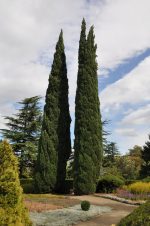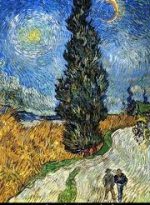 The Mediterranean cypress (Cupressus sempervirens) is an evergreen conifer tree native to southern Europe and western Asia, including Persia where a 4000 year old tree still grows. The dark gray-green leaves are scale like and aromatic when crushed. Trees grow up to seventy feet tall and may be narrow or spreading. They prefer full sun and dry soil, and are hardy in USDA zones 7-10. Photo Credit Wikimedia
The Mediterranean cypress (Cupressus sempervirens) is an evergreen conifer tree native to southern Europe and western Asia, including Persia where a 4000 year old tree still grows. The dark gray-green leaves are scale like and aromatic when crushed. Trees grow up to seventy feet tall and may be narrow or spreading. They prefer full sun and dry soil, and are hardy in USDA zones 7-10. Photo Credit Wikimedia
 After the murder of Gloucester, Suffolk speaks to Queen Margaret,;
After the murder of Gloucester, Suffolk speaks to Queen Margaret,;
Their sweetest shade, a grove of Cypress trees!
2nd Henry VI, act iii, sc. 2, 322
In the camp of the Volsces Aufidius tells a soldier;
I am attended at the Cypress grove.
Coriolanus, act I, sc. 10, 30
The suitor, Gremio, tells Baptista, father of the Bianca whom he wants to marry;
In ivory coffers I have stuffe’d my crowns,
In Cypress chests my arras counterpoints.
Taming of the Shrew, act ii, sc. I, 351
The word cypress is used in Twelfth Night, act ii, sc. 4 but refers to the fabric which is not called crape.
Although Mediterranean cypress is native to dry climates it grows well in England and was introduced there before Shakespeare’s time. The tree was known by the ancient Greeks and Romans who associated the tree with death and the underworld because of its poor ability to regenerate when pruned hard. The ancients used the tree in funerary rituals and used it to make wreaths for statues of Pluto, god of the underworld. A Roman myth related by the poet Ovid tells us about the youth, Cyparissus, who accidentally killed his pet stag and begged to weep forever. As a result, the gods changed him into the tree that bears his name. The specific name, sempervirens refers to the evergreen nature of the tree.